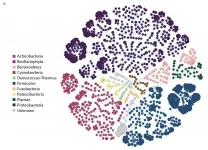(Press-News.org) A recommendation for more intensive blood pressure management from an influential global nonprofit that publishes clinical practice guidelines in kidney disease could, if followed, benefit nearly 25 million Americans, according to an analysis led by researchers at the Johns Hopkins Bloomberg School of Public Health.
The new recommendation from Kidney Disease: Improving Global Outcomes, a global nonprofit that develops evidence-based clinical practice guidelines in kidney disease, is aimed at doctors to help them to reduce blood pressure for chronic kidney disease patients whose systolic blood pressure levels are over 120 mmHg. Blood pressure can be reduced using antihypertensive medications and lifestyle modifications. The analysis indicates that 69.5 percent of chronic kidney disease patients in the United States--a total of 24.5 million people--would meet that criterion.
The study appears alongside the new Kidney Disease: Improving Global Outcomes (KDIGO) guidelines on February 18 in the journal Kidney International.
"This is a major update of an influential set of guidelines for chronic kidney disease patients, and it is coming out against a backdrop of worsening blood pressure control in the U.S.," says study first author Kathryn Foti, PhD, a postdoctoral researcher in the Department of Epidemiology at the Bloomberg School.
Researchers estimate that more than 35 million people in the U.S. have chronic kidney disease, a condition in which the kidneys are damaged and becoming progressively less efficient at filtering wastes from the blood. Unfortunately, awareness and diagnosis of kidney disease is low. High blood pressure is a major cause of chronic kidney disease, a contributor to its worsening, and a major risk factor for cardiovascular disease. Thus, it has long been considered important for chronic kidney disease patients to keep their blood pressure in the normal range, if necessary, with medications including angiotensin converting enzyme (ACE) inhibitors and angiotensin II receptor blockers (ARBs). Because chronic kidney disease is so common, these new clinical guidelines could have a major public health impact.
"Controlling blood pressure is particularly important for the one in seven people in the United States with chronic kidney disease," says Josef Coresh, MD, PhD, the George W. Comstock Professor in the Bloomberg School's Department of Epidemiology. "Reducing blood pressure in adults with chronic kidney disease to the level recommended in the new guidelines could also reduce cardiovascular disease among this group."
The researchers determined from their analysis that Blacks and Asian Americans with chronic kidney disease are more likely than whites to have blood pressure readings above the 2020 Kidney Disease: Improving Global Outcomes target level.
Normal, healthy blood pressure is considered to be below 120 mmHg systolic and 80 mmHg diastolic. The most recent Kidney Disease: Improving Global Outcomes recommendation, in 2012, was for doctors to treat their chronic kidney disease patients as needed to get their blood pressure readings down to, or below, 140 mmHg systolic and 90 mmHg diastolic--and even lower, ?130/?80 mmHg, for those with albuminuria, a protein-in-the-urine sign of more severe chronic kidney disease. In 2017, the American College of Cardiology and American Heart Association jointly issued a recommendation for blood-pressure lowering in chronic kidney disease patients to ?130/?80 mmHg.
In the study, the researchers analyzed blood pressure and other data on a sample of 1,699 U.S. adults with chronic kidney disease in the 2015-2018 National Health and Nutrition Examination Survey to gauge the proportion of chronic kidney disease patients who would potentially benefit from the new KDIGO guidelines.
Their chief finding was that 69.5 percent of U.S. chronic kidney disease patients, or about 24.5 million individuals, are eligible for blood-pressure lowering according to the 2020 KDIGO guideline--compared with 49.8, percent according to the 2012 Kidney Disease: Improving Global Outcomes guidelines, and 55.6 percent, according to the 2017 American College of Cardiology/American Heart Association guidelines.
Thus, about seven million more chronic kidney disease patients are eligible for blood-pressure lowering under the new guidelines compared to the 2012 Kidney Disease: Improving Global Outcomes guidelines--and when using the 2017 American College of Cardiology/American Heart Association guidelines for comparison, about 5 million more are eligible.
The analysis suggests that at the time of the 2015-18 National Health and Nutrition Examination Survey, 14.4 million U.S. adults with chronic kidney disease were not taking blood-pressure lowering medicines. Of these, 61.8 percent, or about 8.9 million U.S. adults, had systolic blood pressure levels over 120 mmHg and thus should consider starting on blood-pressure lowering medicines under the new guidelines.
The authors note that blood pressure control improved in the U.S. over most of the past two decades, although in the last several years that trend has reversed.
INFORMATION:
"Potential Implications of the 2020 KDIGO Blood Pressure Guideline for U.S. Adults with Chronic Kidney Disease" was written by Kathryn Foti, Dan Wang, Alexander Chang, Elizabeth Selvin, Mark Sarnak, Tara Chang, Paul Muntner, and Josef Coresh.
Funding was provided by the National Institutes of Health (T32 HL007024, K23 DK106515, K24 HL152440).
Multi-ethnic neighborhoods in England retain their diversity and are much more stable than such neighborhoods in the U.S., according to geographers from the U.S. and U.K. The team examined how neighborhood diversity has changed on a national scale from 1991 to 2011 using U.K. Census data.
Past studies of this kind have often focused on neighborhoods in which the presence of two or three different ethnic groups constituted a diverse neighborhood but this study applied a more rigorous standard. A multi-ethnic neighborhood had to have at least five or more ethnic groups represented and no group could represent more ...
The cocktail of beneficial bacteria passed from mother to infant through breast milk changes significantly over time and could act like a daily booster shot for infant immunity and metabolism. The research, conducted by scientists from Montreal and Guatemala and published in Frontiers in Microbiology, has important implications for infant development and health.
Researchers discovered a range of microbiome species never before identified in human milk. Until now, relatively little was known about the role microbiome bacteria play in breast milk. These bacteria are thought to protect the infant gastrointestinal tract and improve aspects of long-term health, such as allergy ...
A toxin produced by bacteria as a defence mechanism causes mutations in target bacteria that could help them survive, according to a study published today in eLife.
The finding suggests that competitive encounters between bacterial cells could have profound consequences on the evolution of bacterial populations.
When bacterial cells come into contact, they often produce toxins as a defence mechanism. Although it is known that the bacteria producing these toxins have a competitive advantage, exactly how the toxins affect the recipient cells is less clear.
"Undergoing intoxication is not always detrimental for cells - there are scenarios in which encountering a toxin could provide a benefit, such as generating antibiotic ...
To combat climate change, shifting from fossil fuels to clean and sustainable energy sources is imperative. A popular candidate in this regard is hydrogen, an eco-friendly fuel that produces only water when used. However, the efficient methods of hydrogen production are usually not eco-friendly. The eco-friendly alternative of splitting water with sunlight to produce hydrogen is inefficient and suffers from low stability of the photocatalyst (material that facilitates chemical reactions by absorbing light). How does one address the issue of developing a stable and efficient photocatalyst?
In a study recently published in Applied Catalysis B: Environmental, ...
Having a memory of past events enables us to take smarter decisions about the future. Researchers at the Max-Planck Institute for Dynamics and Self-Organization (MPI-DS) and the Technical University of Munich (TUM) have now identified how the slime mold Physarum polycephalum saves memories - although it has no nervous system.
The ability to store and recover information gives an organism a clear advantage when searching for food or avoiding harmful environments. Traditionally it has been attributed to organisms that have a nervous system.
A new study authored by Mirna Kramar (MPI-DS) and Prof. Karen Alim (TUM and MPI-DS) challenges this view by uncovering the surprising abilities of a highly dynamic, single-celled organism to store and ...
During ice ages, the global mean sea level falls because large amounts sea water are stored in the form of huge continental glaciers. Until now, mathematical models of the last ice age could not reconcile the height of the sea level and the thickness of the glacier masses: the so-called Missing Ice Problem. With new calculations that take into account crustal, gravitational and rotational perturbation of the solid Earth, an international team of climate researchers has succeeded in resolving the discrepancy, among them Dr. Paolo Stocchi from the Royal Netherlands Institute for Sea Research (NIOZ). The study, now published in the ...
During this unique study, a team of researchers led by Professor Jane Ogden from the University of Surrey investigated the impact of actively preparing or watching others prepare food (e.g., on a cooking show) versus distraction away from this focus. Researchers sought to understand how this may affect the amount of food consumed and influence the desire to continue eating.
To investigate this further, eighty female participants were recruited and assigned to one of four groups: active food preparation (preparing a cheese wrap within 10 minutes), video food preparation (watching a video of a researcher preparing a cheese wrap), distraction ...
University of Alberta researchers have found that limiting the amount of fat the body releases into the bloodstream from fat cells during heart failure could help improve outcomes for patients.
In a recent study published in the American Journal of Physiology, Jason Dyck, professor of pediatrics in the Faculty of Medicine & Dentistry and director of the U of A's Cardiovascular Research Centre, found that mice with heart failure that were treated with a drug blocking the release of fat into the bloodstream from fat cells saw less inflammation in the heart and throughout the body, and had better outcomes than a control group.
"Many people believe that, by definition, heart failure is only ...
New Orleans, LA - An LSU Health New Orleans School of Public Health study reports a positive association between social vulnerability and COVID-19 incidence at the census tract level and recommends that more resources be allocated to socially vulnerable populations to reduce the incidence of COVID-19. The findings are published in Frontiers in Public Health, available END ...
Gay men are more likely than lesbian women to face stigma and avoidant prejudice from their heterosexual peers due to the sound of their voice, a new study in the British Journal of Social Psychology reports. Researchers also found that gay men who believe they sound gay anticipate stigma and are more vigilant regarding the reactions of others.
During this unique study researchers from the University of Surrey investigated the role of essentialist beliefs -- the view that every person has a set of attributes that provide an insight into their identity -- of heterosexual, lesbian ...




